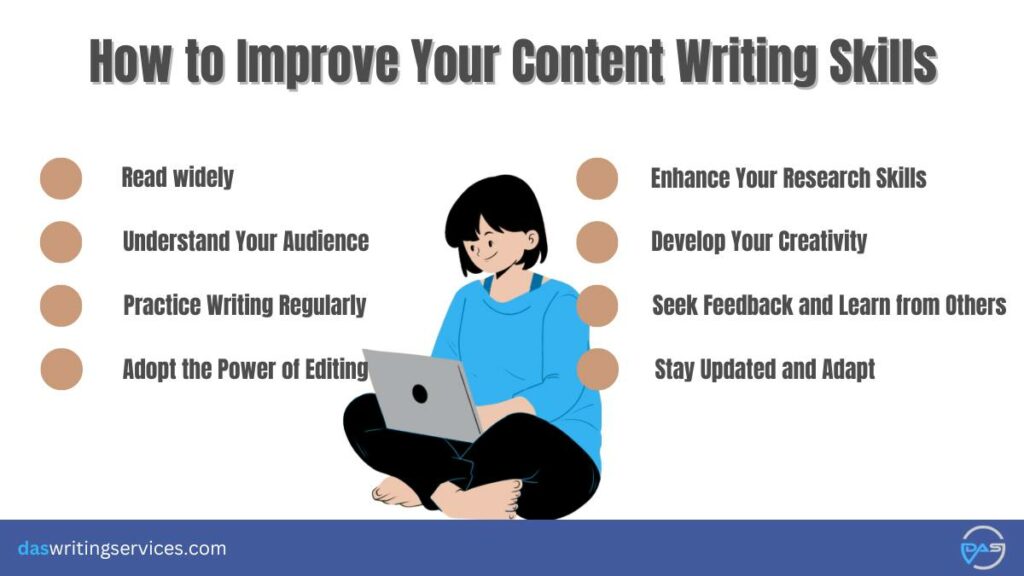Unleash your creativity and master the art of content writing with these essential skills and valuable tips for success.

Image courtesy of via DALL-E 3
Table of Contents
Welcome to the exciting world of becoming a content writer! In this article, we will explore the essential skills and tips you need to kickstart your journey as a content writer. So, what exactly does a content writer do, and why are these skills so important? Let’s dive in and find out!
What is a Content Writer?
A content writer is someone who creates written content for various platforms, such as articles, blog posts, social media posts, and more. They are responsible for engaging readers, conveying information, and ultimately, communicating a message effectively to the target audience.
Why is Content Writing Important?
Good content writing is crucial for businesses and individuals alike. It helps businesses attract and retain customers, build brand reputation, and improve search engine rankings. For individuals, content writing offers a creative outlet to share thoughts, ideas, and expertise with the world.
Writing Skills You Need
Grammar and Spelling
One of the most important writing skills you need as a content writer is having good grammar and spelling. Grammar is like the rules of writing that help your sentences make sense, and spelling is making sure you spell words correctly. When your writing has proper grammar and spelling, it looks more professional and is easier for people to understand.
Building a Strong Vocabulary
Another essential writing skill is building a strong vocabulary. Your vocabulary is all the words you know and use in your writing. The more words you know, the more ways you can express yourself and make your writing interesting. A wide range of words can help you create engaging content that keeps your readers hooked!
Research Skills
Research skills are an essential part of content writing. They help writers find accurate information, support their ideas, and create reliable content for readers.
Finding Credible Sources
When conducting research, it’s important to use credible and trustworthy sources. These sources provide accurate information that can be relied upon. To find credible sources, look for websites that end in .gov, .edu, or .org, as these are often more reliable than .com websites. It’s also important to consider the author’s credentials and the publication date of the information.
Fact-Checking
Fact-checking is the process of verifying the accuracy of the information you use in your writing. Before including any facts or statistics in your content, make sure to double-check them from multiple reliable sources. This helps prevent the spread of misinformation and ensures that your content is trustworthy and accurate.
Understanding Your Audience
When you’re writing content, it’s essential to think about who will be reading it. Understanding your audience can help you create content that engages and resonates with them. Let’s explore how you can tailor your writing to keep your readers interested and connected.

Image courtesy of www.daswritingservices.com via Google Images
Identifying Your Audience
Before you start writing, take some time to think about who your readers will be. Are they students looking for study tips? Parents searching for healthy recipes? By identifying your audience, you can better understand their needs, interests, and preferences.
Writing for Engagement
Once you know who your audience is, you can tailor your writing to keep them engaged. Use language and examples that resonate with your readers. Consider their level of knowledge on the topic and adjust your content accordingly. By making your writing relatable and interesting, you can capture your audience’s attention and keep them coming back for more.
Developing a Writing Style
In the vast world of content writing, one of the most important skills you can develop is your unique writing style. Your writing style includes your voice and tone, which are essential in making your content stand out from the rest. Let’s delve into how you can hone your writing style to captivate your audience!
Finding Your Voice
When it comes to writing, your voice is like your fingerprint – it’s unique to you. Finding your voice means expressing yourself authentically through your writing. To discover your voice, think about what makes you, well, you. Are you funny, serious, or somewhere in between? Do you have a particular way of looking at the world or sharing your experiences? Embrace these qualities and let them shine through in your writing.
Adjusting Your Tone
While your voice remains consistent, your tone can vary depending on the subject matter and audience. Tone refers to the attitude or emotions conveyed in your writing. For example, a piece about a serious topic like climate change would necessitate a more sober tone, while a blog post about a fun DIY project could be lighthearted and upbeat. Understanding how to adjust your tone will help you connect with your readers on a deeper level.
Organizing Your Work
In order to create well-structured and coherent written pieces, it’s essential to organize your work effectively. Here, we will delve into the key strategies for ensuring clarity and organization in your writing process.

Image courtesy of www.daswritingservices.com via Google Images
Creating an Outline
Before starting to write, it’s helpful to create an outline that serves as a roadmap for your content. An outline outlines the main points, subtopics, and structure of your piece, helping you stay focused and on track. Think of it as a skeleton on which you will flesh out your ideas. Start by jotting down the key topics you want to cover and then arrange them in a logical order. This will give your writing a clear direction and flow.
Writing Drafts
Writing a first draft is like laying down the foundation of a house – it provides a starting point for your work. After creating an outline, start writing your first draft without worrying too much about perfection. This initial draft will help you get your ideas down on paper. Once you have completed the draft, go back and revise it. This process of writing and revising multiple drafts allows you to refine your work, improve clarity, and polish your writing to make it the best it can be.
Editing and Proofreading
In this section, we will dive into the crucial processes of editing and proofreading that help content writers enhance the quality of their work.
Self-Editing Techniques
Self-editing is an essential skill that every content writer must master. It involves reviewing and revising your own work to improve clarity, coherence, and readability.
One effective self-editing technique is to read your writing aloud. By listening to the words, you can catch awkward phrasing, repetitive sentences, and grammatical errors that may have slipped by during the initial writing process. This method can help you identify areas that need improvement and refine your content for better communication.
Another useful strategy is to take breaks between writing and editing. Stepping away from your work allows you to come back with a fresh perspective, making it easier to spot mistakes and make necessary enhancements. This way, you can ensure that your content is clear, concise, and engaging for your audience.
Proofreading for Perfection
Proofreading is the final step in the editing process and focuses on meticulously checking for errors in spelling, grammar, punctuation, and overall coherence.
To effectively proofread your work, it’s essential to take your time and pay attention to detail. Start by reviewing your content line by line, examining each word and sentence for accuracy and flow. Look out for common mistakes such as typos, missing punctuation, and inconsistent formatting.
Additionally, consider using tools like spell checkers and grammar checkers to help you identify potential errors that may have been overlooked. While these tools can be helpful, remember that they are not foolproof, and manual proofreading is still necessary to ensure the highest quality of your writing.
By incorporating thorough editing and proofreading practices into your writing routine, you can elevate the standard of your content, effectively communicate your ideas, and captivate your audience with polished and error-free writing.
Building a Portfolio
Creating a strong portfolio is essential for showcasing your writing skills and attracting potential clients or employers. Your portfolio is like a showcase of your best work, demonstrating your talent and expertise in content writing. Here’s how you can build a compelling portfolio to impress others:

Image courtesy of ebookfriendly.com via Google Images
Collecting Writing Samples
Start by gathering a variety of writing samples that highlight your abilities as a content writer. These samples can include blog posts, articles, website content, social media posts, or any other pieces that showcase your writing style and versatility.
When selecting writing samples for your portfolio, aim to include a diverse range of topics and writing styles. This will demonstrate your ability to adapt to different formats and audience preferences. Make sure your samples are well-written, error-free, and engaging to capture the attention of potential clients.
Showcasing Your Best Work
Once you have collected a selection of writing samples, it’s time to showcase your best work in your portfolio. Create a professional and visually appealing portfolio website or document where you can display your samples in an organized and easily accessible manner.
Include a brief description or introduction for each writing sample, highlighting the purpose of the piece, the target audience, and any positive results or feedback you received. Make sure to provide links or attachments to the full text of each sample for viewers to read.
Consider adding testimonials or recommendations from past clients or colleagues to add credibility to your portfolio. This social proof can help build trust with potential clients and demonstrate your expertise in content writing.
Update your portfolio regularly with new writing samples and projects to showcase your growth and continued success as a content writer. By maintaining a polished and up-to-date portfolio, you can effectively market your skills and attract exciting writing opportunities.
Conclusion
In this article, we’ve covered a lot of ground on the topic of becoming a content writer. Here’s a quick summary of the key points we discussed:
Summary of Key Points
We started by defining what a content writer does – creating articles, blog posts, and other written content for various platforms. We then delved into the importance of content writing, highlighting how it helps businesses and individuals communicate effectively. Next, we explored the essential writing skills every content writer needs, such as grammar, spelling, and vocabulary. We also discussed the significance of research skills in content writing, emphasizing the importance of finding credible sources and fact-checking information.
Understanding your audience was another crucial aspect we covered, including identifying your target audience and writing for engagement. Developing a writing style that is unique and adjusting your tone based on the subject and audience were also key points we touched on. We then looked at how to organize your work effectively through creating outlines and writing multiple drafts for refinement.
Editing and proofreading were highlighted as essential processes for improving the quality of your content writing. We discussed self-editing techniques and the importance of thorough proofreading for perfection. Finally, we explored the importance of building a portfolio to showcase your writing skills and attract potential clients.
Concluding Thoughts
As you embark on your journey to becoming a content writer, remember the key skills and tips we’ve discussed in this article. Practice regularly, seek feedback, and continue to refine your writing. With dedication and hard work, you can excel in this field and create impactful content that resonates with your audience.
Want to turn these SEO insights into real results? Seorocket is an all-in-one AI SEO solution that uses the power of AI to analyze your competition and craft high-ranking content.
Seorocket offers a suite of powerful tools, including a Keyword Researcher to find the most profitable keywords, an AI Writer to generate unique and Google-friendly content, and an Automatic Publisher to schedule and publish your content directly to your website. Plus, you’ll get real-time performance tracking so you can see exactly what’s working and make adjustments as needed.
Stop just reading about SEO – take action with Seorocket and skyrocket your search rankings today. Sign up for a free trial and see the difference Seorocket can make for your website!
FAQs
Common Queries
As you’re learning about becoming a content writer, you might have some questions popping up in your mind. Here are a few common ones:
Q: What exactly does a content writer do?
A: A content writer creates various written pieces like articles, blog posts, and website content for different platforms. They help businesses and individuals effectively communicate their message to their audience.
Q: Why is content writing important?
A: Good content writing is crucial because it helps convey information clearly and engagingly. It can attract readers, boost website traffic, and ultimately, help achieve business goals.
Q: What skills do I need to become a content writer?
A: To excel as a content writer, you need strong writing skills, a good grasp of grammar and spelling, a wide vocabulary, research skills to find credible information, and the ability to understand your audience and engage them with your writing.
Q: How can I develop my own writing style?
A: Everyone has a unique voice in writing. To find yours, experiment with different styles, practice writing regularly, and pay attention to what resonates with your audience. Over time, you’ll develop a distinct writing style that sets you apart.
Q: Do I need a portfolio to become a content writer?
A: Having a portfolio is beneficial as it showcases your writing skills to potential clients or employers. Collecting writing samples and presenting your best work helps demonstrate your capabilities and attract opportunities in the field of content writing.
Hopefully, these answers help clear up some of the common questions you may have about starting a career as a content writer!







